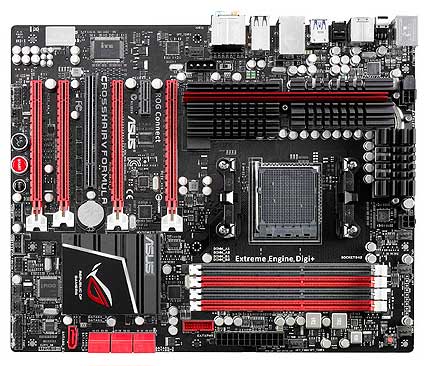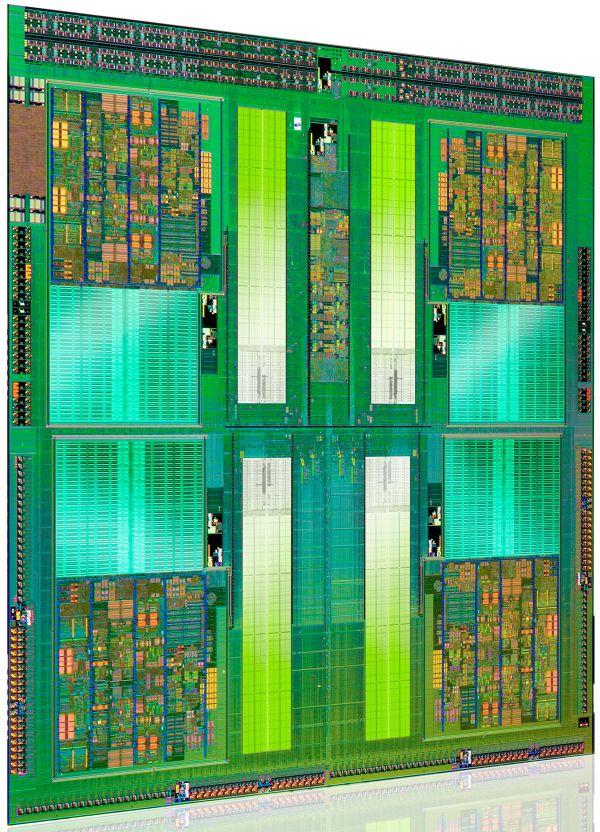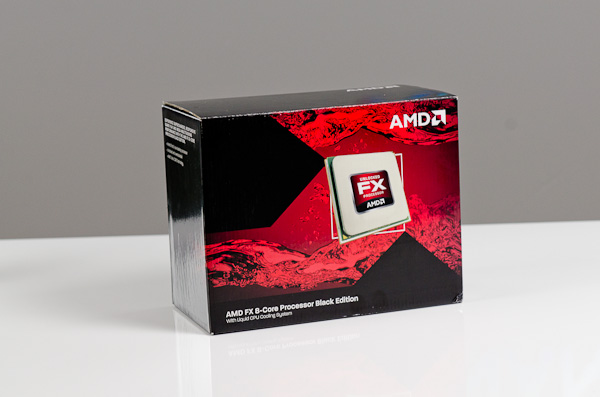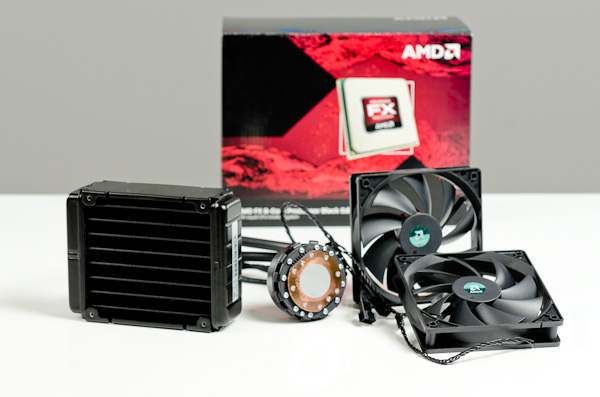The Bulldozer Review: AMD FX-8150 Tested
by Anand Lal Shimpi on October 12, 2011 1:27 AM ESTAMD has been trailing Intel in the x86 performance space for years now. Ever since the introduction of the first Core 2 processors in 2006, AMD hasn't been able to recover and return to the heyday of the Athlon 64 and Athlon 64 X2. Instead the company has remained relevant by driving costs down and competing largely in the sub-$200 microprocessor space. AMD's ability to hold on was largely due to its more-cores-for-less strategy. Thanks to aggressive pricing on its triple and hexa-core parts, for users who needed tons of cores, AMD has been delivering a lot of value over the past couple of years.
Recently however Intel has been able to drive its per-core performance up with Sandy Bridge, where it's becoming increasingly difficult to recommend AMD alternatives with higher core counts. The heavily threaded desktop niche is tough to sell to, particularly when you force users to take a significant hit on single threaded performance in order to achieve value there. For a while now AMD has needed a brand new architecture, something that could lead to dominance in heavily threaded workloads while addressing its deficiencies in lightly threaded consumer workloads. After much waiting, we get that new architecture today. Bulldozer is here.
It's branded the AMD FX processor and it's only available in a single die configuration. Measuring 315mm2 and weighing in at around 2 billion transistors (that's nearly GPU-sized fellas), Bulldozer isn't that much smaller than existing 45nm 6-core Phenom II designs despite being built on Global Foundries' 32nm SOI process. Both die area and transistor count are up significantly over Sandy Bridge, which on Intel's 32nm HKMG process is only 995M transistors with a die size of 216mm2. This is one big chip.
| CPU Specification Comparison | ||||||||
| CPU | Manufacturing Process | Cores | Transistor Count | Die Size | ||||
| AMD Bulldozer 8C | 32nm | 8 | 1.2B* | 315mm2 | ||||
| AMD Thuban 6C | 45nm | 6 | 904M | 346mm2 | ||||
| AMD Deneb 4C | 45nm | 4 | 758M | 258mm2 | ||||
| Intel Gulftown 6C | 32nm | 6 | 1.17B | 240mm2 | ||||
| Intel Nehalem/Bloomfield 4C | 45nm | 4 | 731M | 263mm2 | ||||
| Intel Sandy Bridge 4C | 32nm | 4 | 995M | 216mm2 | ||||
| Intel Lynnfield 4C | 45nm | 4 | 774M | 296mm2 | ||||
| Intel Clarkdale 2C | 32nm | 2 | 384M | 81mm2 | ||||
| Intel Sandy Bridge 2C (GT1) | 32nm | 2 | 504M | 131mm2 | ||||
| Intel Sandy Bridge 2C (GT2) | 32nm | 2 | 624M | 149mm2 | ||||
Update: AMD originally told us Bulldozer was a 2B transistor chip. It has since told us that the 8C Bulldozer is actually 1.2B transistors. The die size is still accurate at 315mm2.
Architecturally Bulldozer is a significant departure from anything we've ever seen before. We'll go into greater detail later on in this piece, but the building block in AMD's latest architecture is the Bulldozer module. Each module features two integer cores and a shared floating point core. FP hardware is larger and used less frequently in desktop (and server workloads), so AMD decided to share it between every two cores rather than offer a 1:1 ratio between int/fp cores on Bulldozer. AMD advertises Bulldozer based FX parts based on the number of integer cores. Thus a two module Bulldozer CPU, has four integer cores (and 2 FP cores) and is thus sold as a quad-core CPU. A four module Bulldozer part with eight integer cores is called an eight-core CPU. There are obvious implications from a performance standpoint, but we'll get to those shortly.
The FX Lineup
There are a total of 7 AMD FX CPUs that AMD is announcing today, although only four are slated for near-term availability.
| CPU Specification Comparison | |||||||||
| Processor | Cores | Clock Speed | Max Turbo | NB Clock | L2 Cache | TDP | Price | ||
| AMD FX-8150 | 8 | 3.6GHz | 4.2GHz | 2.2GHz | 8MB | 125W | $245 | ||
| AMD FX-8120 | 8 | 3.1GHz | 4.0GHz | 2.2GHz | 8MB | 95W/125W | $205 | ||
| AMD FX-8100* | 8 | 2.8GHz | 3.7GHz | 2GHz | 8MB | 95W | N/A | ||
| AMD FX-6100 | 6 | 3.3GHz | 3.9GHz | 2GHz | 6MB | 95W | $165 | ||
| AMD FX-4170* | 4 | 4.2GHz | 4.3GHz | 2.2GHz | 4MB | 125W | N/A | ||
| AMD FX-B4150* | 4 | 3.8GHz | 4GHz | 2.2GHz | 4MB | 95W | N/A | ||
| AMD FX-4100 | 4 | 3.6GHz | 3.8GHz | 2GHz | 4MB | 95W | $115 | ||
| AMD Phenom II X6 1100T | 6 | 3.2GHz | 3.6GHz | 2GHz | 3MB | 125W | $190 | ||
| AMD Phenom II X4 980 | 4 | 3.7GHz | N/A | 2GHz | 2MB | 125W | $170 | ||
The FX-8150, 8120, 6100 and 4100 are what's launching today. The first digit in AMD's FX model numbers indicates the number of cores with the 8150 and 8120 boasting eight, while the 6100 only has six active integer cores (three Bulldozer modules). The FX-4100 features four integer cores. L2 cache scales with core count (2MB per module), while the L3 cache size remains fixed at 8MB regardless of SKU.
North Bridge and L3 cache frequency alternate between 2.0GHz and 2.2GHz depending on the part. TDPs range between 95W and 125W as well, with the FX-8120 being offered in both 125W and 95W versions.
There's only a single Bulldozer die. The 6 and 4 core versions simply feature cores disabled on the die. AMD insists this time around, core unlocking won't be possible on these harvested parts.
The huge gap in clock speed between the 8120 and 8150 are troubling. Typically we see linear frequency graduations but the fact that there's a 16% difference between these two SKUs seems to point to process problems limiting yield at higher frequencies—at least for the 8-core version.
Outside of the quad-core and hex-core Bulldozer pats, the only other FX processor able to exceed the 3.3GHz clock speed of the Phenom II X6 1100T is the 8150. And if you include quad-core Phenom II parts in the mix, only two Bulldozer parts ship at a higher stock frequency than the Phenom II X4 980. Granted Turbo Core will help push frequencies even higher, but these low base frequencies are troubling. For an architecture that was designed to scale to clock speeds 30% higher than its predecessor, Bulldozer doesn't seem to be coming anywhere close.
The entire FX lineup ships unlocked, which allows for some easy overclocking as you'll see soon enough.
Motherboard Compatibility
AMD is certifying its FX processors for use on Socket-AM3+ motherboards. Owners of standard AM3 motherboards may be out of luck, although motherboard manufacturers can choose to certify their boards for use with Bulldozer if they wish to do so. From AMD's perspective however, only AM3+ motherboards with BIOS/UEFI support for Bulldozer are officially supported.
All existing AM2/AM2+/AM3/AM3+ heatsinks should work with the FX processor; they simply need to be rated for the TDP of the processor you're looking to cool.

For this review, AMD supplied us with ASUS' Crosshair V Formula AM3+ motherboard based on AMD's 990FX chipset.
AMD does offer six 6Gbps SATA ports on its 990FX chipset, a significant upgrade from the two 6Gbps ports on Intel's 6-series chipsets. Unbuffered ECC memory is also supported for those who desire the added security, once again a feature not supported on Intel's consumer grade 6-series chipsets.
Despite AMD's trend towards releasing APUs with integrated GPUs (thus requiring a new socket), AMD insists that the AM3+ platform will live to see one more processor generation before it's retired.
AMD's Liquid CPU Cooling System
Alongside its new FX processors AMD is introducing its first branded liquid cooling system manufactured by Asetek.
AMD's cooling system is similar to other offerings from companies like Antec and Corsair. The system is self contained, you never have to worry about adding any more liquid to it.
Attach the cooling module to your CPU socket via a simple bracket, and affix the radiator to your case and you're good to go. The radiator is cooled via two 120mm fans, also included in the box.
AMD doesn't have an exact idea on pricing or availability of its liquid cooling solution, but I'm told to expect it to be around $100 once available. My sample actually arrived less than 12 hours ago, so expect a follow up with performance analysis later this week.
The Roadmap
For the first time in far too long, AMD is actually being very forthcoming about its future plans. At a recent tech day about Bulldozer, AMD laid out its CPU core roadmap through 2014. The code names are below:
Piledriver you already know about, it's at the heart of Trinity, which is the 2—4 core APU due out in early 2012. Piledriver will increase CPU core performance by around 10—15% over Bulldozer, although it will initially appear in a lower performance segment. Remember that final generation of AM3+ CPU I mentioned earlier? I fully expect that to be a GPU-less Piledriver CPU due out sometime in 2012.
Steamroller will follow in 2013, again improving performance (at the core level) by around 10—15%. Excavator will do the same in 2014. AMD believes that these performance increases will be sufficient to keep up with Intel over time, however I'll let you be the judge of that once we get to the Bulldozer performance numbers.
The other thing to note about AMD's roadmap is it effectively puts the x86 business on an annual cadence, in line with what we've seen from the AMD GPU folks. Although AMD isn't talking about what process nodes to expect all of these cores at, it looks like AMD will finally have an answer to Intel's tick-tock release schedule moving forward.























430 Comments
View All Comments
vtohthree - Wednesday, October 12, 2011 - link
..but because Intel doesn't have to try hard to compete, here we were sitting as consumers waiting for a proper response from AMD so that Intel would be on their toes to unleash more potential in their chips or lower prices, but this is sort of sad...ET - Wednesday, October 12, 2011 - link
I recently bought a Phenom II X6 1090T to upgrade an X3 710. Looks like a better deal now. BD's power draw in particular is disappointing. No doubt Intel is what I'd recommend to others. I've have been using AMD CPU's for several years now (Athlon XP 2100+ was my first), and I still like AMD, but I'm disappointed by BD, especially after the long wait.Loki726 - Wednesday, October 12, 2011 - link
Thanks Anand for the compiler benchmarks.It seems like performance on bulldozer is highly application dependent, better at data-parallel and worse (even than Phenom) on irregular and sequential applications.
I'll probably skip this one.
I don't mind this tradeoff, but the problem is that AMD already has a good data-parallel architecture (their GPU). I'n my opinion they are moving their CPU in the wrong direction. No one wants an x86 throughput processor. They shouldn't be moving the CPU towards the GPU architecture.
AMD: Don't pay the OOO/complex decoder penalty for all of your cores. If your app is running on multiple cores, it is obviously parallel. Don't add hardware that wastes power trying to rediscover it. Then, throw all your power budget at a single or a few x86 cores.
Beat Intel at single threaded perf and then use your GPU for gaming, and throughput processing (video, encryption, etc).
I'm not a fan of Intel, but they got this right. If they get over their x86 obsession and get their data-parallel act together they are going to completely dominate the desktop and high end.
dubyadubya - Wednesday, October 12, 2011 - link
Care to share which tests are 64 bit? Each bench program used must specify if its 32 or 64 bit. Why do all review sites forget to includet this critical info? From the limited results I can find on the net AMD see's a large performance increase running 64 bit code over 32 bit code while Intel see's little if any increase.HangFire - Wednesday, October 12, 2011 - link
I've got an Asus board that promises to support BD, and I've holding off upgrading my unlocked/overclocked 550BE for literally months, and for this? I might as well just get a Phenom II quad or 6-core.I've said all along that AMD needs to address their clock versus instruction efficiency to be competitive. To do that they need to redesign their cores and stop dragging along their old K8 cores.
So here we are with Bulldozer, Wider front end, TurboCore now works, floating point decoupled, 8 (int) cores, and... still flogging the same instruction efficiency as the old K8 cores (at least, the integer portion of them).
Oh, yeah, I'm sure at the right price point some server farms will be happy with them, and priced low enough, they can hold on to the value portion of the marketplace. To do both they'll have to compete aggressively on price, and be prepared to lose money, both of which they seem to be good at.
Like Anand said, we need to see someone actually compete with Intel, but it appears that AMD has lost the ability to invent new processor cores, it can only manipulate existing designs. Instead of upgrading the CPU, it looks like I'll go for a full Intel upgrade, unless I can find an 1100T real cheap. Hmm, that's probably a real possibility. I'm sure a lot of AMD fans are going to be trading them in now that they see what their AM3 upgrade path is(n't).
alpha754293 - Wednesday, October 12, 2011 - link
I think that you should clarify the difference between what you call "server" workloads (i.e. OLTP/virtualization vs. HPC).I suspect that with one shared FP between two ALUs; HPC performance is going to suffer.
The somewhat-computationally intensive benchmarks that you've shown today already gives an early indication that the Bulldozer-based Opterons are going to suffer greatly with HPC benchmarks.
On that note: I would like to see you guys run the standard NCAC LS-DYNA benchmarks or the Fluent benchmarks if you can get them. They'll give me a really good idea as to how server processors perform in HPC applications (besides the ones that you guys have been running already). Johan has my email, so feel free to ask if you've got questions about them.
Ananke - Wednesday, October 12, 2011 - link
Bulldozer reminds me of Sun's (Oracle) Niagara architecture. It seems AMD aimed the server and professional market. It makes business sense. The profit margins there are net 50-60% (this is AFTER the marketing, support, etc overhead costs) and along with the high performance work stations is the only growing market as of now. Hence, the stock market lifted the stocks of AMD. Gaming and enthusiast market is around 0.7% of CPU revenue - yep, that is, I work with this kind of statistics data, guys.This is a promising architecture (despite the fact that is not good for home enthusiasts). AMD should focus on providing more I/O lanes through the CPU - aka PCI lanes on cheaper boards without requirement of additional chips. It will allow placing more GPUs using overall cheaper infrastructure - exactly the way HPC and server market is evolving. Then, they should really get a good software team and make/support/promote SDK for general GPU computing in line of what NVidia did with CUDA.
For anything mainstream / aka Best Buy, Walmart, etc./ Llano is good enough.
As I said, this Bulldozer chip apparently is not good for enthusiasts, and Anandtech is an enthusiast site, but unfortunately this is just a very small niche market. People should not bash a product, because it doesn't fit only their needs. It is OK for the vast market.
GatorLord - Wednesday, October 12, 2011 - link
Thanks for the VERY interesting stats. I had a hunch it made good sense, but since I don't work with these data it was just a hunch in the end. Now it's better...maybe a hunch plus. We should feel lucky that they even pay any attention to this segment...I suspect they do b/c a lot of decision influencers are also computer racers at home.alpha754293 - Thursday, October 13, 2011 - link
One thing that I will also say/add is that while people are perhaps grossly disappointed with the results; think about it this way:What you've really got is a quad-core (I don't count their ALUs as cores, just FPUs) processor doing a 6-core job.
So if they went to a 6-module chip, the benefits can actually be substantial.
And on the 8-module server processor, it can be bigger even still.
And yes, this is very much like the UltraSPARC T-series (which, originally was designed by UltraDense as a network switching chip), but even they eventually added a FPU per core, rather than just one FPU per chip.
The downside to the 8-module chip is a) it's going to be massive, and b) it won't be at the clock speeds it NEEDs to be to compete.
Icehawk - Wednesday, October 12, 2011 - link
I quickly ran the Rage vt_benchmark and got ~.64 @ 1thread and .25 for 2-6 threads which is what your Intel #s line up with - BUT I'm running a Q6600, 4gb, and a GTS 250... shouldn't I see much worse scores compared to a i7/current get video card? Is this something to do with Rage's *awesome* textures or?